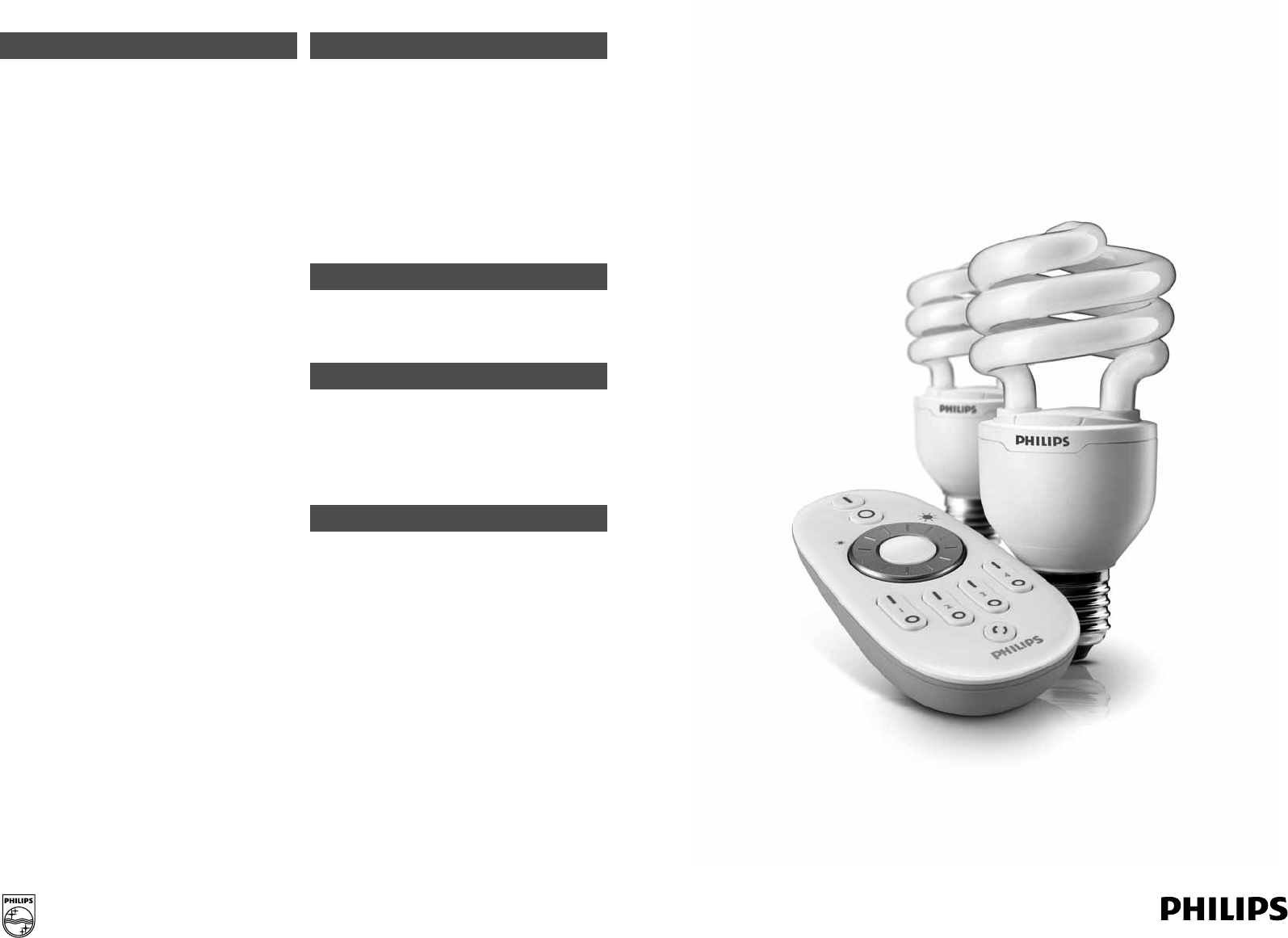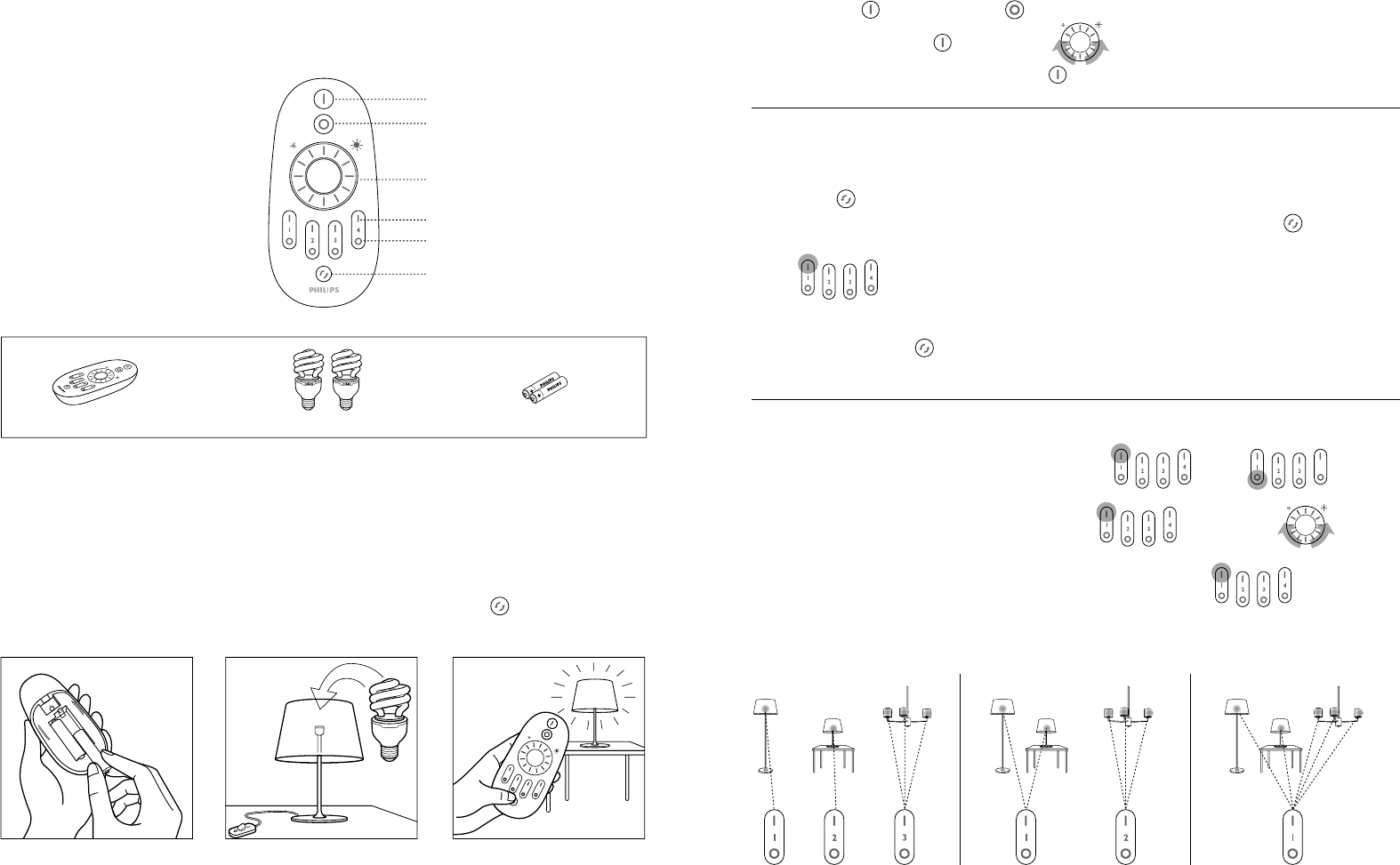Philips Electronics Singapore HRC0301 RF remote control for Lighting application User Manual
Philips Electronics Singapore Pte Ltd RF remote control for Lighting application
Manual

Quick start guide
EasyScene
www.philips.com© 2009 Koninklijke Philips Electronics N.V.
All rights reserved
How much power is consumed when the bulbs are
in standby mode?
The power consumption for a bulb in standby mode is
approximately 0.27 watt or 0.1% of the energy used by
a normal incandescent bulb.
Will my bulb connection or numbering be affected
if I remove the batteries from the remote control?
No. The lamps will function as previously configured.
The bulb numbering will not be affected.
What is the maximum number of bulbs a remote
control can be connected to?
One remote control can be connected with up to
100 EasyScene bulbs.
Can I use two remote controls to control one bulb?
No. One EasyScene bulb can only be controlled
by one remote control at any one time.
What is the range of the remote control?
IEEE 802.15.4 is the standard used. Its operating range in
approximately 15m and the operating frequency is 2.4 GHz.
Do I have to point the remote control at bulbs to operate?
No. The wireless protocol used in the system is Radio
Frequency (RF) which does not require a line of sight.
Can I reset my EasyScene?
Yes. Follow steps below :
1. All connected EasyScene bulbs should be switched on.
2. Remove battery cover of the remote control.
3. Press reset button (next to the batteries) until EasyScene
bulbs flash.
4. Turn power switch of the EasyScene bulbs Off and On
again.The bulb will have a 10 second delay to register
before lighting.
5. The dimming dial on the remote control will remain lit
until the system is ready to be used.
6. Repeat connecting process of bulbs with remote control.
Why do EasyScene bulbs not respond immediately after
changing batteries?
The bulbs have a 10 second delay to register the new
batteries. The dimming dial on the remote control will
remain lit until system is ready to be used.
Where can I find more information on this EasyScene set?
Please refer to www.philips.com
Frequently Asked Questions (FAQ)
EasyScene bulbs not responding to remote control:
• check batteries in remote control
• check the power of the light fitting is switched on
• go through connecting process again to confirm
connection of remote control with bulb
• press reset button (next to the batteries) to clear lamps
and remote control to default factory settings before
repeating connecting process
EasyScene bulbs are performing functions on their own:
• unintentional "hijacking" by another remote control may
have occurred. Go through connecting process again
to connect remote control with bulb.
TROUBLESHOOTING
Warranty and Service
Environment
Philips' 1 year warranty is valid if the product is used
in accordance with the instructions and for it intended
purpose. Claims will only be accepted on submission of
the original proof of purchase (invoice, sales slip or receipt)
stating the purchase date, the name of dealer and a
description of the product. The Philips warranty lapses if:
• anything has been changed, crossed out, deleted or
rendered illegible on the receipt or product description.
• failures caused by damage, faulty connections or abuse.
• a defect is caused by extreme circumstances not inherent
to the product such as water contact, fire, incorrect use
or negligence.
• product has been opened (for reasons other than
changing batteries) or disassembled.
Warranty
For information or in case of a problem, please visit the
Philips website at www.philips.com or contact your local
Philips customer hotline.
lf you discard the product in due course, please dispose of
it in accordance with the instructions of the local authority.
Remove the batteries when you discard the remote
control. Do not dispose of batteries with the normal
household waste. They should be disposed of in an
environmentally friendly way.
C
M
Y
CM
MY
CY
CMY
K
QSG.ai 1 70.71 lpi 45.00° 15/05/2009 2:01 PMQSG.ai 1 70.71 lpi 45.00° 15/05/2009 2:01 PM
Process BlackProcess Black

• For On or Off of numbered bulb press selected number On or Off
• For dimming of numbered bulb press selected number On before rotating
• For instant full brightness of numbered bulb, double press selected number On
Before first use of EasyScene, the remote control and individual EasyScene bulbs must be connected in order to
operate together. It is not necessary to point the remote control at the lamp. Please follow steps below to connect.
Philips EasyScene gives you wireless control of your lights from a convenient remote control. Simply change
your existing lightbulbs to EasyScene energy savers to enjoy complete control of your lighting, including
dimming, at your fingertips.
Note : If connecting does not occur as normal, switch the bulb off and on again and retry connecting steps above.
YOUR EASYSCENE IS NOW READY FOR USE.
Easy control at your fingertips
Setup Instructions
Using numbered EasyScene bulbs
Examples of numbering bulbs
1. Bulb should be switched on.
2. Quick press
3. A bulb will blink to show that it selected. If the bulb you want to select is not blinking, press again to cycle
through bulbs until the correct one blinks.
4. Press of the number that you want to assign bulb while bulb is still blinking.
5. The bulb will flash to confirm successful numbering
Note : If you mistakenly press a bulb will start blinking. Leave for 10 seconds or press any other button
(eg. dimming dial) to stop the bulb blinking. Take care not to unintentionally re-number bulb.
Numbering EasyScene bulbs
IMPORTANT
STEP 1
Open the battery compartment
on the back of the remote control
and insert 2 AAA batteries.
Usage Instructions
• For All On press or for All Off press
• For dimming of all bulbs press before rotating
• For instant full brightness of all bulbs, double press
STEP 2
Switch off power for selected light
fitting before installing bulb, then
switch power on.
STEP 3
Hold for 3 seconds until bulb
flashes confirming connection with
remote control.
EXAMPLE 1 EXAMPLE 2 EXAMPLE 3
2 AAA Batteries 1 EasyScene Remote Control
Pack contents
AAA
AAA
2 EasyScene Bulbs
Dimming dial
All On button
All Off button
Select button
Number On button
Number Off button
1234
PHILIPS
1234
PHILIPS
reset
PHILIPS
PHILIPS
C
M
Y
CM
MY
CY
CMY
K
QSG.ai 1 70.71 lpi 45.00° 15/05/2009 1:57 PMQSG.ai 1 70.71 lpi 45.00° 15/05/2009 1:57 PM
Process BlackProcess Black
Federal Communication Commission Interference Statement
This equipment has been tested and found to comply with the limits for a Class B digital device, pursuant to Part 15 of the FCC Rules. These limits are designed to provide reasonable protection
against harmful interference in a residential installation. This equipment generates, uses and can radiate radio frequency energy and, if not installed and used in accordance with the instructions,
may cause harmful interference to radio communications. However, there is no guarantee that interference will not occur in a particular installation. If this equipment does cause harmful
interference to radio or television reception, which can be determined by turning the equipment off and on, the user is encouraged to try to correct the interference by one of the following measures:
to confirm successful numbering
- Reorient or relocate the receiving antenna.
- Increase the separation between the equipment and receiver.
- Connect the equipment into an outlet on a circuit different from that to which the receiver is connected.
- Consult the dealer or an experienced radio/TV technician for help.
FCC Caution: Any changes or modifications not expressly approved by the party responsible for compliance could void the user's authority to operate this equipment.
This device complies with Part 15 of the FCC Rules. Operation is subject to the following two conditions: (1) This device may not cause harmful interference, and (2) this device must accept any
interference received, including interference that may cause undesired operation.
IMPORTANT NOTE:
FCC Radiation Exposure Statement:
This equipment complies with FCC radiation exposure limits set forth for an uncontrolled environment. This transmitter must not be co-located or operating in conjunction with any other antenna or
transmitter.